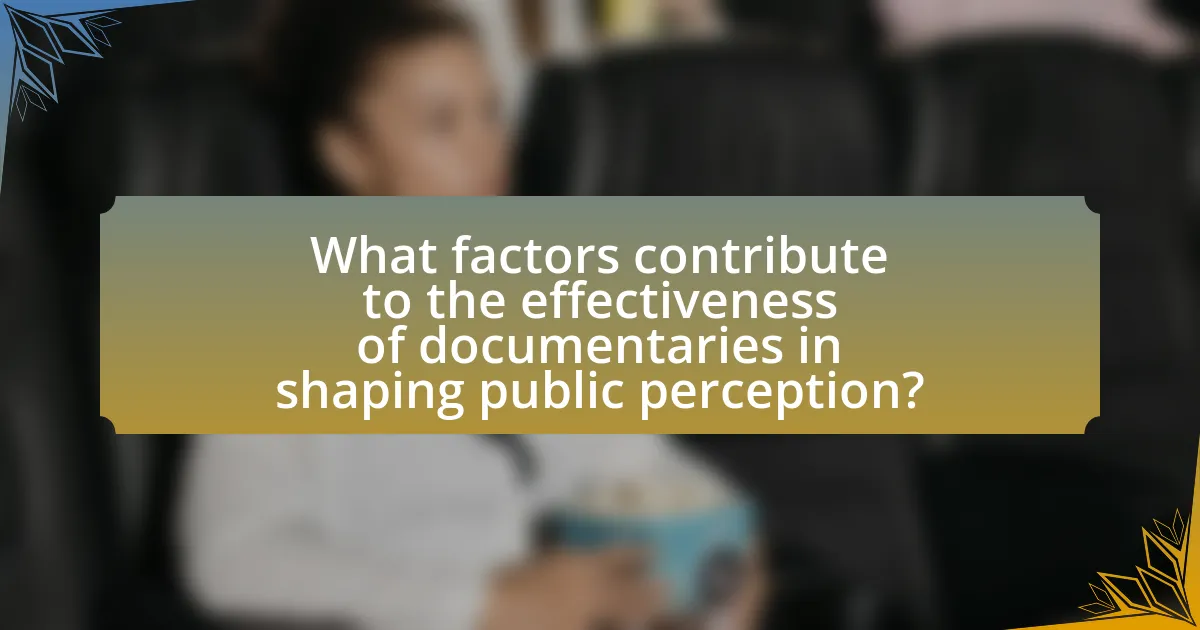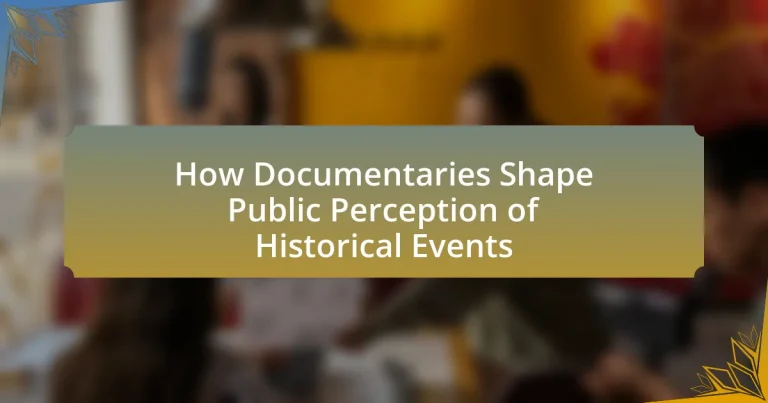Documentaries play a significant role in shaping public perception of historical events by presenting factual narratives that enhance understanding and emotional engagement. They utilize techniques such as archival footage, expert interviews, and narrative storytelling to convey complex histories, often highlighting marginalized perspectives. The effectiveness of documentaries is influenced by factors such as source credibility, narrative structure, and emotional resonance, which can alter viewers’ beliefs and attitudes. Additionally, audience demographics, including age and education level, impact how historical narratives are interpreted, making documentaries a powerful medium for both education and critical engagement with history.

How do Documentaries Influence Public Understanding of Historical Events?
Documentaries influence public understanding of historical events by presenting factual narratives that shape perceptions and interpretations. Through visual storytelling, documentaries often highlight specific aspects of history, making complex events more accessible and engaging for audiences. For example, Ken Burns’ “The Civil War” effectively brought the American Civil War to life, using primary sources and expert commentary to provide a nuanced understanding of the conflict. Research indicates that viewers of historical documentaries are more likely to retain information and develop a deeper emotional connection to the events portrayed, as evidenced by studies showing increased knowledge retention among audiences after viewing such films. This combination of factual content and emotional engagement can significantly alter public perceptions and discussions surrounding historical events.
What role do documentaries play in shaping historical narratives?
Documentaries play a crucial role in shaping historical narratives by presenting visual and auditory representations of events, which influence public understanding and perception. They often serve as primary sources of information, providing context, analysis, and emotional engagement that textbooks or written accounts may lack. For instance, documentaries like “The Fog of War” offer insights into the complexities of war through interviews and archival footage, thereby framing historical events in a way that resonates with viewers. This visual storytelling can highlight specific perspectives, often emphasizing the experiences of marginalized groups, which can alter mainstream historical narratives. Research indicates that documentaries can significantly impact viewers’ beliefs and attitudes about history, as they often evoke emotional responses that facilitate retention and understanding of the material presented.
How do filmmakers select which historical events to document?
Filmmakers select historical events to document based on their relevance, emotional impact, and potential to engage audiences. They often consider events that resonate with contemporary issues or societal themes, ensuring that the narrative connects with viewers on a personal level. For instance, documentaries about the Civil Rights Movement highlight ongoing discussions about racial equality, making them timely and significant. Additionally, filmmakers may analyze existing gaps in historical representation, aiming to shed light on underrepresented narratives, such as women’s contributions during World War II. This approach not only informs but also shapes public perception by providing diverse perspectives on history.
What techniques do documentaries use to present historical facts?
Documentaries use techniques such as archival footage, expert interviews, and narrative storytelling to present historical facts. Archival footage provides authentic visual evidence of past events, enhancing credibility and engagement. Expert interviews with historians or eyewitnesses offer authoritative perspectives, adding depth and context to the narrative. Narrative storytelling weaves these elements together, creating a compelling and coherent account that helps viewers understand the significance of historical events. For instance, the documentary “The Fog of War” utilizes Robert S. McNamara’s insights alongside archival footage to explore the complexities of war, illustrating how these techniques effectively convey historical truths.
Why are documentaries considered a powerful medium for historical storytelling?
Documentaries are considered a powerful medium for historical storytelling because they combine visual imagery, narrative structure, and factual content to engage audiences emotionally and intellectually. This format allows viewers to witness historical events and figures in a compelling way, often using primary sources such as interviews, archival footage, and expert commentary to provide authenticity. For instance, the documentary “The Act of Killing” presents the Indonesian mass killings of 1965-66 through the perspectives of the perpetrators, offering a unique insight into the psychological and social dimensions of historical violence. This immersive approach not only informs viewers but also shapes their understanding and perception of historical events, making documentaries a significant tool in public discourse about history.
How do visual elements enhance the storytelling of historical events?
Visual elements enhance the storytelling of historical events by providing immediate context and emotional resonance that text alone cannot convey. For instance, archival footage, photographs, and animations can vividly illustrate key moments, making them more relatable and impactful for viewers. Research indicates that visual storytelling can increase retention of information by up to 65%, as seen in studies conducted by the University of California, which found that people remember visual content significantly better than verbal information. This ability to evoke emotions and create a connection with the audience allows documentaries to shape public perception more effectively, as visuals can highlight the human experience behind historical events, fostering empathy and understanding.
What emotional impact do documentaries have on viewers’ perceptions?
Documentaries significantly influence viewers’ perceptions by evoking strong emotional responses that shape their understanding of historical events. These films often present real-life stories and factual narratives, which can create empathy and a deeper connection to the subject matter. For instance, studies have shown that documentaries like “13th” and “The Act of Killing” have altered public perceptions regarding systemic racism and the complexities of genocide, respectively, by humanizing the subjects and presenting emotional truths. This emotional engagement can lead to increased awareness, shifts in attitudes, and even motivate social action among viewers, demonstrating the powerful role documentaries play in shaping public perception.

What factors contribute to the effectiveness of documentaries in shaping public perception?
The effectiveness of documentaries in shaping public perception is primarily influenced by their narrative structure, emotional engagement, and factual accuracy. Documentaries often employ compelling storytelling techniques that create a relatable context, making complex issues more accessible to viewers. Emotional engagement is achieved through personal stories and visuals that resonate with audiences, fostering empathy and connection. Furthermore, factual accuracy is crucial; documentaries that present well-researched information and credible sources enhance their authority and trustworthiness, which can significantly impact public opinion. For instance, the documentary “13th” by Ava DuVernay effectively combines these elements to address systemic racism in the United States, leading to increased awareness and discussion around the topic.
How does the credibility of sources affect documentary impact?
The credibility of sources significantly affects the impact of documentaries by influencing audience trust and engagement. When documentaries utilize reputable sources, such as experts, primary documents, or verified data, they enhance their authority and reliability, leading to a stronger emotional and intellectual connection with viewers. For instance, a study by the Pew Research Center found that audiences are more likely to accept and share information from documentaries that cite credible experts, thereby amplifying the documentary’s reach and influence on public perception. Conversely, documentaries that rely on questionable or biased sources can lead to misinformation, diminishing their effectiveness and potentially skewing public understanding of historical events.
What types of sources do documentaries typically rely on?
Documentaries typically rely on primary sources, secondary sources, expert interviews, archival footage, and statistical data. Primary sources include original documents, photographs, and firsthand accounts that provide direct evidence of the subject matter. Secondary sources consist of analyses, interpretations, and summaries of primary data, often found in books and articles. Expert interviews offer insights from individuals with specialized knowledge, enhancing credibility. Archival footage serves as visual evidence from the time period being discussed, while statistical data supports claims with quantifiable information. These diverse sources collectively contribute to a documentary’s authenticity and depth, shaping public perception of historical events.
How do biases in source material influence the portrayal of history?
Biases in source material significantly influence the portrayal of history by shaping the narratives and perspectives presented to audiences. When historical accounts are derived from biased sources, they often reflect the viewpoints, agendas, or cultural contexts of those who created them, leading to a skewed understanding of events. For example, primary sources like letters, diaries, or official documents may omit critical perspectives or emphasize certain details while downplaying others, resulting in a one-dimensional view of historical events. This selective representation can perpetuate stereotypes, reinforce power dynamics, and create misconceptions about the past, as seen in documentaries that rely heavily on specific narratives without acknowledging alternative viewpoints. Consequently, the portrayal of history becomes a reflection of the biases inherent in the source material, affecting public perception and understanding of historical events.
What audience demographics are most influenced by historical documentaries?
The audience demographics most influenced by historical documentaries are typically adults aged 25 to 54, with a notable interest in education and history. Research indicates that this age group is more likely to engage with content that provides historical context, as they often seek to understand the complexities of past events. Additionally, individuals with higher education levels, particularly those holding college degrees, show a greater tendency to be influenced by historical documentaries, as they are more likely to appreciate the analytical perspectives presented. Studies have shown that viewers in this demographic often report changes in their understanding of historical events after watching documentaries, highlighting the impact of this medium on their perceptions.
How do age and education level affect viewer interpretation of documentaries?
Age and education level significantly influence viewer interpretation of documentaries. Older viewers may rely on their life experiences and historical context, leading to a more critical analysis of the content, while younger viewers might approach documentaries with a more open mindset, often influenced by contemporary issues. Education level also plays a crucial role; individuals with higher education tend to engage more critically with the material, analyzing the arguments presented and questioning biases, whereas those with lower education levels may accept the information at face value. Research indicates that viewers with advanced degrees are more likely to seek out additional sources to verify claims made in documentaries, enhancing their understanding and interpretation of the subject matter.
What role does cultural background play in understanding historical narratives?
Cultural background significantly influences the understanding of historical narratives by shaping individuals’ perspectives, values, and interpretations of events. For instance, people from different cultural backgrounds may prioritize various historical events based on their societal values, leading to divergent interpretations. Research indicates that cultural context affects memory and perception, as demonstrated in studies like “Cultural Differences in Memory: The Role of Culture in the Encoding and Retrieval of Memories” by Nisbett and Masuda, which shows how East Asian and Western cultures recall events differently due to their distinct cultural frameworks. This illustrates that cultural background not only informs what individuals remember but also how they construct meaning from historical narratives, ultimately affecting public perception shaped by documentaries.

How can documentaries be used to critically engage with historical events?
Documentaries can be used to critically engage with historical events by presenting factual narratives that challenge prevailing interpretations and encourage viewers to question established historical accounts. For instance, documentaries like “13th” by Ava DuVernay examine the historical context of racial inequality in the United States, linking past injustices to contemporary issues, thereby prompting critical reflection on systemic racism. This engagement is further enhanced through the use of primary sources, expert interviews, and archival footage, which provide a multifaceted view of history and stimulate discussions about its implications. By framing historical events within broader social, political, and cultural contexts, documentaries foster a deeper understanding and critical analysis of the past.
What strategies can viewers employ to analyze documentaries critically?
Viewers can employ several strategies to analyze documentaries critically, including evaluating the source of the documentary, examining the evidence presented, and considering the filmmaker’s perspective. Evaluating the source involves assessing the credibility of the production company and the filmmakers, as reputable sources are more likely to present accurate information. Examining the evidence requires viewers to look for supporting data, such as statistics, expert interviews, and primary sources, to determine the validity of the claims made. Considering the filmmaker’s perspective entails recognizing potential biases or agendas that may influence the narrative, as documentaries often reflect the viewpoints of their creators. These strategies enable viewers to engage with documentaries thoughtfully and discern the impact they may have on public perception of historical events.
How can viewers identify bias and perspective in documentary films?
Viewers can identify bias and perspective in documentary films by critically analyzing the film’s content, including the selection of topics, the framing of narratives, and the representation of sources. For instance, if a documentary predominantly features interviews with individuals who share a specific viewpoint while neglecting opposing perspectives, it may indicate a bias. Additionally, the language used in narration and the emotional tone can reveal the filmmaker’s perspective, as emotionally charged language may sway viewers’ opinions. Research shows that documentaries often shape public perception by emphasizing certain facts while omitting others, which can lead to a skewed understanding of historical events. Therefore, viewers should assess the balance of viewpoints presented and consider the filmmakers’ intentions to discern bias effectively.
What questions should viewers ask to assess the accuracy of historical representation?
Viewers should ask whether the documentary provides credible sources for its claims. This question is crucial because documentaries that accurately represent history typically cite primary sources, expert interviews, and peer-reviewed research. For instance, a documentary on World War II should reference historical documents, testimonies from veterans, or works by historians specializing in that era. Additionally, viewers should inquire about the perspectives included in the documentary. A balanced representation often includes multiple viewpoints, especially on contentious issues, which can be verified through historical records and scholarly debates. Lastly, viewers should consider the context in which the documentary was produced, including the creators’ backgrounds and potential biases, as this can influence the portrayal of historical events.
What are the best practices for creating impactful historical documentaries?
The best practices for creating impactful historical documentaries include thorough research, engaging storytelling, and high production quality. Thorough research ensures accuracy and credibility, as seen in Ken Burns’ documentaries, which often rely on extensive archival materials and expert interviews. Engaging storytelling captivates audiences; for instance, using personal narratives can humanize historical events, making them relatable. High production quality, including clear visuals and sound, enhances viewer experience, as demonstrated by the use of advanced cinematography techniques in “The Civil War.” These practices collectively contribute to a documentary’s ability to shape public perception of historical events effectively.
How can filmmakers balance entertainment and educational value in documentaries?
Filmmakers can balance entertainment and educational value in documentaries by integrating compelling storytelling techniques with factual content. Engaging narratives, character development, and visual aesthetics can captivate audiences while delivering informative insights. For instance, the documentary “13th” by Ava DuVernay effectively combines historical analysis of racial inequality in the U.S. with powerful personal stories, making complex social issues accessible and engaging. This approach not only entertains but also educates viewers about systemic injustices, demonstrating that well-crafted documentaries can influence public perception and understanding of historical events.
What ethical considerations should be taken into account when producing historical content?
When producing historical content, ethical considerations include accuracy, representation, and sensitivity to the subjects involved. Accuracy is crucial; historical content must be factually correct to avoid misleading audiences, as seen in the backlash against documentaries that misrepresent events, such as the inaccuracies in “The History Channel’s” portrayal of World War II. Representation involves ensuring diverse perspectives are included, particularly those of marginalized groups, to provide a comprehensive view of history. Sensitivity is essential when addressing traumatic events; creators should approach subjects like genocide or war with care to avoid re-traumatizing affected communities. These considerations help maintain integrity and foster trust with audiences.


